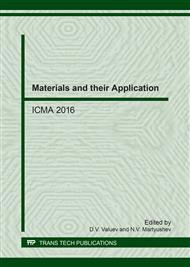p.81
p.86
p.91
p.95
p.101
p.105
p.110
p.116
p.122
The Effect of Additionally Introduced Impurities of Fe and Pb Ions on Silver Azide Decomposition
Abstract:
The experiments have emphasized that additionally introduced impurities of Fe and Pb ions are relevant to the initiation of slow and explosive decomposition of silver azide crystals by the external electric field and UV irradiation. External gas release was used for research purpose. Test-sensitivity is 10−12 mole. Time-to-explosion was measured by a stop watch. It’s been found out that the reaction of slow decomposition in silver azide under the action of electric field turns into explosion faster in samples with the additionally introduced impurities. The samples with additionally introduced Fe are the most explosive ones (time-to-explosion 3 minutes). The authors have assumed that external influence can generate non-equilibrium charge carriers (holes), which become localized on cationic vacancies and support formation of reactive sites. As soon as cut off concentration of these sites is reached, the solid-phase chain reaction turns into explosion. The growing concentration of impurity influences on the number of reactive sites, making their concentration critical. In view of the results obtained in experiments a procedure for monitoring the decomposition of crystals is suggested, which necessitates additional introduction of Fe and Pb ions.
Info:
Periodical:
Pages:
101-104
Citation:
Online since:
June 2017
Keywords:
Price:
Сopyright:
© 2017 Trans Tech Publications Ltd. All Rights Reserved
Share:
Citation:


